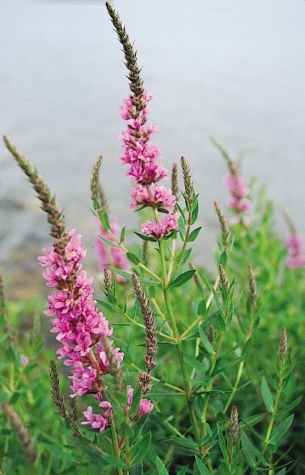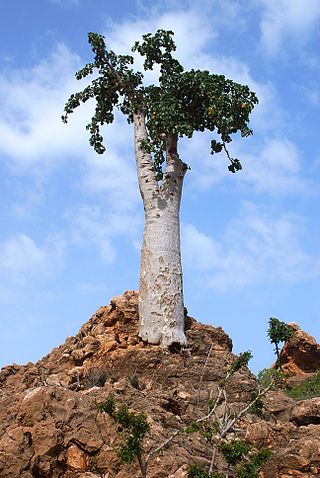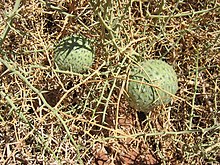
The Cucurbitaceae, also called cucurbits or the gourd family, are a plant family consisting of about 965 species in around 95 genera. Those most important to humans are the following:

Gourds include the fruits of some flowering plant species in the family Cucurbitaceae, particularly Cucurbita and Lagenaria. The term refers to a number of species and subspecies, many with hard shells, and some without. One of the earliest domesticated types of plants, subspecies of the bottle gourd, Lagenaria siceraria, have been discovered in archaeological sites dating from as early as 13,000 BCE. Gourds have had numerous uses throughout history, including as tools, musical instruments, objects of art, film, and food.

Cucurbita is a genus of herbaceous fruits in the gourd family, Cucurbitaceae, native to the Andes and Mesoamerica. Five edible species are grown and consumed for their flesh and seeds. They are variously known as squash, pumpkin, or gourd, depending on species, variety, and local parlance. Other kinds of gourd, also called bottle-gourds, are native to Africa and belong to the genus Lagenaria, which is in the same family and subfamily as Cucurbita, but in a different tribe. These other gourds are used as utensils or vessels, and their young fruits are eaten much like those of the Cucurbita species.

A melon is any of various plants of the family Cucurbitaceae with sweet, edible, and fleshy fruit. The word "melon" can refer to either the plant or specifically to the fruit. Botanically, a melon is a kind of berry, specifically a "pepo". The word melon derives from Latin melopepo, which is the latinization of the Greek μηλοπέπων (mēlopepōn), meaning "melon", itself a compound of μῆλον (mēlon), "apple", treefruit " and πέπων (pepōn), amongst others "a kind of gourd or melon". Many different cultivars have been produced, particularly of cantaloupes.

Ranunculaceae is a family of over 2,000 known species of flowering plants in 43 genera, distributed worldwide.

Cucurbita pepo is a cultivated plant of the genus Cucurbita. It yields varieties of winter squash and pumpkin, but the most widespread varieties belong to the subspecies Cucurbita pepo subsp. pepo, called summer squash.

Lythraceae is a family of flowering plants, including 32 genera, with about 620 species of herbs, shrubs, and trees. The larger genera include Cuphea, Lagerstroemia (56), Nesaea (50), Rotala (45), and Lythrum (35). It also includes the pomegranate and the water caltrop. Lythraceae has a worldwide distribution, with most species in the tropics, but ranging into temperate climate regions as well.

Bombacaceae were long recognised as a family of flowering plants or Angiospermae. The family name was based on the type genus Bombax. As is true for many botanical names, circumscription and status of the taxon has varied with taxonomic point of view, and currently the preference is to transfer most of the erstwhile family Bombacaceae to the subfamily Bombacoideae within the family Malvaceae in the order Malvales. The rest of the family were transferred to other taxa, notably the new family Durionaceae. Irrespective of current taxonomic status, many of the species originally included in the Bombacaceae are of considerable ecological, historical, horticultural, and economic importance, such as balsa, kapok, baobab and durian.

Calabash, also known as bottle gourd, white-flowered gourd, long melon, birdhouse gourd, New Guinea bean, Tasmania bean, and opo squash, is a vine grown for its fruit. It can be either harvested young to be consumed as a vegetable, or harvested mature to be dried and used as a utensil, container, or a musical instrument. When it is fresh, the fruit has a light green smooth skin and white flesh.

Polypodiaceae is a family of ferns. In the Pteridophyte Phylogeny Group classification of 2016, the family includes around 65 genera and an estimated 1,650 species and is placed in the order Polypodiales, suborder Polypodiineae. A broader circumscription has also been used, in which the family includes other families kept separate in PPG I. Nearly all species are epiphytes, but some are terrestrial.

Lagenaria is a genus of gourd-bearing vines in the squash family (Cucurbitaceae). Lagenaria contains six species, all of which are indigenous to tropical Africa. The best-known species, the calabash or bottle gourd, L. siceraria, has been domesticated by humans, and has spread beyond Africa. The other species are not cultivated. The gourds of the various species may be harvested young and used as a vegetable. More commonly, the gourds are harvested mature, then dried, and used in making utensils. Gourds of L. siceraria have been used to store water and other liquids since ancient times. The generic name lagenaria comes from classical Latin lagena meaning bottle or flask, plus Latin suffix -aria.

Cucurbita ficifolia is a species of squash, grown for its edible seeds, fruit, and greens. It has common names including Asian pumpkin, black seed squash, chilacayote, cidra, fig-leaf gourd, and Malabar gourd. Compared to other domesticated species in its genus, investigators have noted that samples of C. ficifolia from throughout its range are relatively similar to one other in morphology and genetic composition. Variations do occur in fruit and seed color, some isozymes, and photoperiod sensitivity.

Trichosanthes cucumerina is a tropical or subtropical vine. Its variety T. cucumerina var. anguina raised for its strikingly long fruit. In Asia, it is eaten immature as a vegetable much like the summer squash and in Africa, the reddish pulp of mature snake gourd is used as an economical substitute for tomato. Common names for the cultivated variety include snake gourd, serpent gourd, chichindapadwal and Snake Tomato.

In botany, a berry is a fleshy fruit without a stone (pit) produced from a single flower containing one ovary. Berries so defined include grapes, currants, and tomatoes, as well as cucumbers, eggplants (aubergines) and bananas, but exclude certain fruits that meet the culinary definition of berries, such as strawberries and raspberries. The berry is the most common type of fleshy fruit in which the entire outer layer of the ovary wall ripens into a potentially edible "pericarp". Berries may be formed from one or more carpels from the same flower. The seeds are usually embedded in the fleshy interior of the ovary, but there are some non-fleshy exceptions, such as Capsicum species, with air rather than pulp around their seeds.

Dendrosicyos is a monotypic genus in the plant family Cucurbitaceae. The only species is Dendrosicyos socotranus, the cucumber tree. The species is endemic to the island of Socotra in Yemen, and is the only species in the Cucurbitaceae to grow in a tree form. The species name was originally spelled D. socotrana, but this is corrected to masculine grammatical gender according to the International Code of Nomenclature for algae, fungi, and plants.

Baridinae is a subfamily of true weevils (Curculionidae). It was established by Carl Johan Schönherr in 1836. Some 4,300 species in 550 genera are placed here, most of which occur in the New World. A few are economically significant pests, while others are in turn used for biocontrol of invasive plant pests. This subfamily also contains a few endangered species.

Lagenaria sphaerica is a herbaceous climber in the family Cucurbitaceae. It is commonly known as the wild melon.
The Nhandiroboideae are a paraphyletic basal group of genera in the Cucurbitaceae, or gourd family, of flowering plants. The Nhandiroboideae comprise all members of the Cucurbitaceae that do not belong to the Cucurbitoideae.

The Cucurbiteae are a tribe of the subfamily Cucurbitoideae, which is part of the flowering plant family Cucurbitaceae (gourds). Species are usually monoecious herbaceous annuals or woody lianas.

Polypodioideae is a subfamily belonging to the fern family Polypodiaceae, which is a member of the suborder Polypodiineae in the Pteridophyte Phylogeny Group classification of 2016 (PPG I). Alternatively, the subfamily may be treated as the tribe Polypodieae within a very broadly defined family Polypodiaceae sensu lato.


















